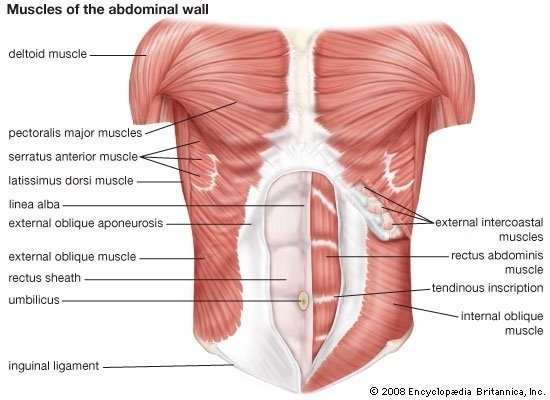What Is Rectus Abdominis Muscle/Rectus abdominis muscle is composed of a pair of vertically oriented muscles. They are one of the two pairs of muscles that contribute to the anterior abdominal wall. The name rectus abdominis means straight abdominal and is indicative of the parallel direction the fibers of the muscle take as they pass from their origin to their point of insertion. The muscle has a strap-like shape, and is narrower inferiorly, widening as it passes superiorly.
The rectus abdominis muscle, also known as the abdominal muscle or abs, is a paired muscle running vertically on each side of the anterior wall of the human abdomen, as well as that of some other mammals. There are two parallel muscles, separated by a midline band of connective tissue called the linea alba. It extends from the pubic symphysis, pubic crest, and pubic tubercle inferiorly, to the xiphoid process and costal cartilages of ribs V to VII superiorly. The proximal attachments are the pubic crest and the pubic symphysis. It attaches distally at the costal cartilages of ribs 5-7 and the xiphoid process of the sternum.[rx]
Anatomy of Rectus Abdominis Muscle
- The rectus abdominis is a long flat muscle, which extends along the whole length of the front of the abdomen, and is separated from its fellow of the opposite side by the linea alba. Tendinous intersections (encryptions tendinae) further subdivide each rectus abdominis muscle into a series of smaller false muscle bellies. Tensing of the rectus abdominis causes the muscle to expand between each tendinous intersection, resulting in the characteristic six or eight pack observed in individuals with low body fat.[rx]
- The upper portion, attached principally to the cartilage of the fifth rib, usually has some fibers of insertion into the anterior extremity of the rib itself.
- It is typically around 10 mm thick (compared to 20 mm thick superficial fat),[rx] or 20 mm thick in young athletes such as handball players.[rx] Typical volume is around 300 cm³ in non-active individuals or almost 500 cm³ in athletes (tennis players).[rx]
Origin
- Rectus abdominis arises by two heads. The first head, the medial one, arises from the front of symphysis pubis while the second head, the lateral and larger, from the pubic crest.
Insertion
- The muscle is inserted into the fifth, sixth and seventh costal cartilages and the xiphoid process.
Blood Supply of Rectus Abdominis Muscle
The rectus abdominis has many sources of arterial blood supply. Classification of the vascular anatomy of muscles
- First, the inferior epigastric artery and vein (or veins) run superiorly on the posterior surface of the rectus abdominis, enter the rectus fascia at the arcuate line, and serve the lower part of the muscle.
- Second, the superior epigastric artery, a terminal branch of the internal thoracic artery, supplies blood to the upper portion. Finally, numerous small segmental contributions come from the lower six intercostal arteries as well. Small terminal branches from the lower three posterior intercostal arteries, the subcostal artery, the posterior lumbar arteries, and the deep circumflex artery may provide some contribution.
Nerve Supply of Rectus Abdominis Muscle
- The muscles are innervated by thoracoabdominal nerves, these are continuations of the T7-T11 intercostal nerves and pierce the anterior layer of the rectus sheath. Sensory supply is from the 7-12 thoracic nerves
- The sternalis muscle may be a variant form of the pectoralis major or the rectus abdominis. Some fibers are occasionally connected with the costoxiphoid ligaments and the side of the xiphoid process.
- This muscle is innervated by the terminal branches of the anterior rami of the lower six thoracic nerves via the lower intercostal nerves and the subcostal nerve.
The Function of Rectus Abdominis Muscle
- The rectus abdominis is an important postural muscle. It is responsible for flexing the lumbar spine, as when doing a so-called “crunch” sit up. The rib cage is brought up to where the pelvis is when the pelvis is fixed, or the pelvis can be brought towards the rib cage (posterior pelvic tilt) when the rib cage is fixed, such as in a leg-hip raise. The two can also be brought together simultaneously when neither is fixed in space.
- The rectus abdominis assists with breathing and plays an important role in respiration when forcefully exhaling, as seen after exercise as well as in conditions where exhalation is difficult such as emphysema. It also helps in keeping the internal organs intact and in creating intra-abdominal pressure, such as when exercising or lifting heavy weights, during forceful defecation or parturition (childbirth).
Actions of Rectus Abdominis
Rectus abdominis, along with other muscles of the anterior abdominal wall, perform a number of important functions.
- It helps in compression of the abdominal contents to facilitate the processes of micturition, parturition, and defecation.
- It flexes the vertebral column.
- It acts as an accessory muscle of expiration.
- It contributes to the maintenance of the tone of the abdominal wall.
References
[bg_collapse view=”button-orange” color=”#4a4949″ expand_text=”Show More” collapse_text=”Show Less” ]
- https://www.ncbi.nlm.nih.gov/pubmed/2969596
- https://www.ncbi.nlm.nih.gov/books/NBK537153/
- https://www.ncbi.nlm.nih.gov/books/NBK459392/
- https://www.ncbi.nlm.nih.gov/books/NBK470334/
- https://www.ncbi.nlm.nih.gov/pmc/articles/PMC4525496/
- https://www.ncbi.nlm.nih.gov/pmc/articles/PMC6717088/
- https://www.sciencedirect.com/topics/veterinary-science-and-veterinary-medicine/rectus-abdominis-muscle
- https://www.ajronline.org/doi/10.2214/AJR.04.1929
- http://www.meddean.luc.edu/lumen/MedEd/GrossAnatomy/dissector/mml/reca.htm
- https://www.getbodysmart.com/abdomen-muscles/rectus-abdominis-muscle
- https://www.mananatomy.com/body-systems/muscular-system/rectus-abdominis
- https://study.com/academy/topic/muscles-of-the-head.html
- https://www.britannica.com/science/rectus-abdominis-muscle
- https://www.kenhub.com/en/library/anatomy/anterior-abdominal-muscles
[/bg_collapse]

Visitor Rating: 5 Stars